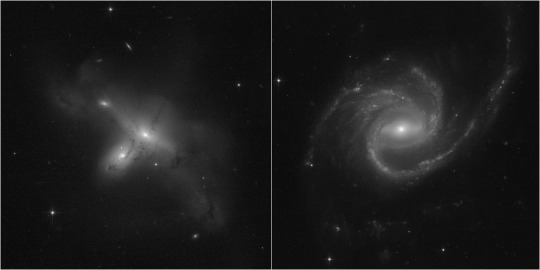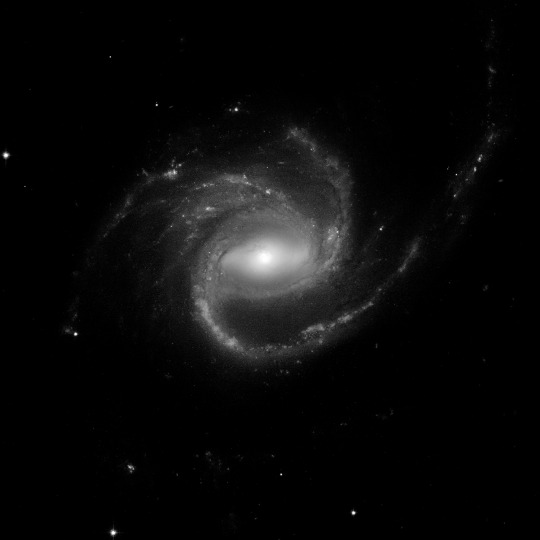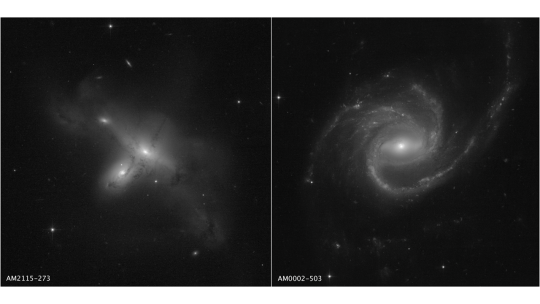#ARP-MADORE2115-273
Text
Телескоп «Хаббл» після ремонту зробив перші тестові світлини
Телескоп «Хаббл» після ремонту зробив перші тестові світлини
Телескоп Hubble, який є спільним проектом Національного управління з аеронавтики й дослідження космічного простору США (National Aeronautics and Space Administration, NASA) та Європейського космічного агентства (European Space Agency, ESA), після ремонту зробив перші тестові світлини.
На лівому кадрі зображений космічний об’єкт ARP-MADORE2115-273, який знаходиться приблизно за 297 мільйонів…

View On WordPress
#ARP-MADORE0002-503#ARP-MADORE2115-273#Космічний об’єкт#Ремонт#США#Телескоп#Хаббл#ESA#European Space Agency#HST#Hubble#Hubble Space Telescope#NASA#USA
0 notes
Photo


ARP-MADORE0002-503 (top) is a large three-arm-spiral galaxy with a distance of 490 million light-years, making it three times larger than our Milky Way Galaxy.
ARP-MADORE2115-273 (bottom) is a rare pair of interacting galaxies, seen in the Southern Hemisphere, and located 297 million light years away from Earth.
Original photography from The Hubble Space Telescope, via Hubblesite.
#space#galaxy#nasa#star#the hubble space telescope#Hubble Telescope#that legend#non kpop#for my spacenerd boyfriend
252 notes
·
View notes
Text

These early snapshots demonstrate Hubble's return to full science operations, following correction of a computer anomaly aboard the spacecraft. Normal science observations were restarted on July 17, at 1:18 pm EDT. Among the early targets are globular star clusters in other galaxies and aurorae on the giant planet Jupiter, in addition to a look at bizarre galaxies.
These two peculiar galaxies are part of a program led by Julianne Dalcanton of the University of Washington in Seattle, to survey oddball galaxies scattered across the sky.
[Left-panel] — ARP-MADORE2115-273 is a rare example of an interacting galaxy pair in the southern hemisphere. These Hubble observations provide Hubble's first high-resolution glimpse at this intriguing system, which is located 297 million light-years away. Astronomers had previously thought this was a "collisional ring" system due to the head-on merger of two galaxies. The new Hubble observations show that the ongoing interaction between the galaxies is far more complex, leaving behind a rich network of stars and dusty gas.
[Right-panel] — ARP-MADORE0002-503 is a large spiral galaxy with unusual, extended spiral arms, at a distance of 490 million light-years. Its arms extend out to a radius of 163,000 light-years, making it three times more expansive than our Milky Way Galaxy. While most disk galaxies have an even number of spiral arms, this one has three.
https://hubblesite.org/contents/media/images/2021/045/01FAXH3M6HCRGJ6JJEMPSC7A96?news=true
12 notes
·
View notes
Photo

FIRST IMAGES FROM REBOOTED HUBBLE: ASTRONOMERS PEER AT ODDBALL GALAXIES These early snapshots demonstrate Hubble's return to full science operations, following correction of a computer anomaly aboard the spacecraft. Normal science observations were restarted on July 17, at 1:18 pm EDT. Among the early targets are globular star clusters in other galaxies and aurorae on the giant planet Jupiter, in addition to a look at bizarre galaxies. These two peculiar galaxies are part of a program led by Julianne Dalcanton of the University of Washington in Seattle, to survey oddball galaxies scattered across the sky. [Left-panel] — ARP-MADORE2115-273 is a rare example of an interacting galaxy pair in the southern hemisphere. These Hubble observations provide Hubble's first high-resolution glimpse at this intriguing system, which is located 297 million light-years away. Astronomers had previously thought this was a "collisional ring" system due to the head-on merger of two galaxies. The new Hubble observatons show that the ongoing interaction between the galaxies is far more complex, leaving behind a rich network of stars and dusty gas. [Right-panel] — ARP-MADORE0002-503 is a large spiral galaxy with unusual, extended spiral arms, at a distance of 490 million light-years. Its arms extend out to a radius of 163,000 light-years, making it three times more expansive than our Milky Way Galaxy. While most disk galaxies have an even number of spiral arms, this one has three. "I'll confess to having had a few nervous moments during Hubble's shutdown, but I also had faith in NASA's amazing engineers and technicians. Everyone is incredibly grateful, and we're excited to get back to science!" said Dalcanton. The Hubble Space Telescope is a project of international cooperation between NASA and ESA (European Space Agency). NASA’s Goddard Space Flight Center in Greenbelt, Maryland, manages the telescope. The Space Telescope Science Institute (STScI) in Baltimore, Maryland, conducts Hubble science operations. STScI is operated for NASA by the Association of Universities for Research in Astronomy in Washington, D.C.
7 notes
·
View notes
Text
Hubble retorna às operações científicas
Hubble retorna às operações científicas

Estes primeiros instantâneos demonstram o retorno do Telescópio Espacial Hubble da NASA / ESA às operações científicas completas, após a correção de uma anomalia do computador a bordo da espaçonave. As observações científicas normais foram reiniciadas em 17 de julho, às 13h18 EDT. Entre os primeiros alvos estão aglomerados de estrelas globulares em outras galáxias e auroras no planeta gigante Júpiter, além de uma visão de galáxias bizarras.
Essas duas galáxias peculiares fazem parte de um programa liderado por Julianne Dalcanton, da Universidade de Washington em Seattle, para pesquisar galáxias estranhas espalhadas pelo céu.
ESQUERDA – ARP-MADORE2115-273 é um raro exemplo de um par de galáxias interagindo no hemisfério sul. Essas observações do Hubble fornecem o primeiro vislumbre de alta resolução do Hubble neste sistema intrigante, que está localizado a 297 milhões de anos-luz de distância. Os astrônomos pensaram anteriormente que este era um sistema de “anel colisional” devido à fusão frontal de duas galáxias. As novas observações do Hubble mostram que a interação contínua entre as galáxias é muito mais complexa, deixando para trás uma rica rede de estrelas e gás empoeirado.
À DIREITA – ARP-MADORE0002-503 é uma grande galáxia espiral com braços espirais estendidos incomuns, a uma distância de 490 milhões de anos-luz. Seus braços se estendem por um raio de 163.000 anos-luz, tornando-o três vezes mais expansivo que a Via Láctea. Enquanto a maioria das galáxias de disco têm um número par de braços espirais, esta possui três.
Créditos: NASA, ESA, STScI, Julianne Dalcanton (UW), Alyssa Pagan (STScI); CC BY 4.0
The post Hubble retorna às operações científicas appeared first on Fotos Publicas.
source https://fotospublicas.com/hubble-retorna-as-operacoes-cientificas/
0 notes
Text
Hubble torna alle osservazioni scientifiche complete e rilascia nuove immagini
Hubble torna alle osservazioni scientifiche complete e rilascia nuove immagini
Queste immagini, da un programma guidato da Julianne Dalcanton dell’Università di Washington a Seattle, dimostrano il ritorno di Hubble alle operazioni scientifiche complete. ARP-MADORE2115-273 è un esempio raramente osservato di una coppia di galassie interagenti nell’emisfero sud. A destra ARP-MADORE0002-503 è una grande galassia a spirale con insoliti ed estesi bracci a spirale. Mentre la…

View On WordPress
0 notes